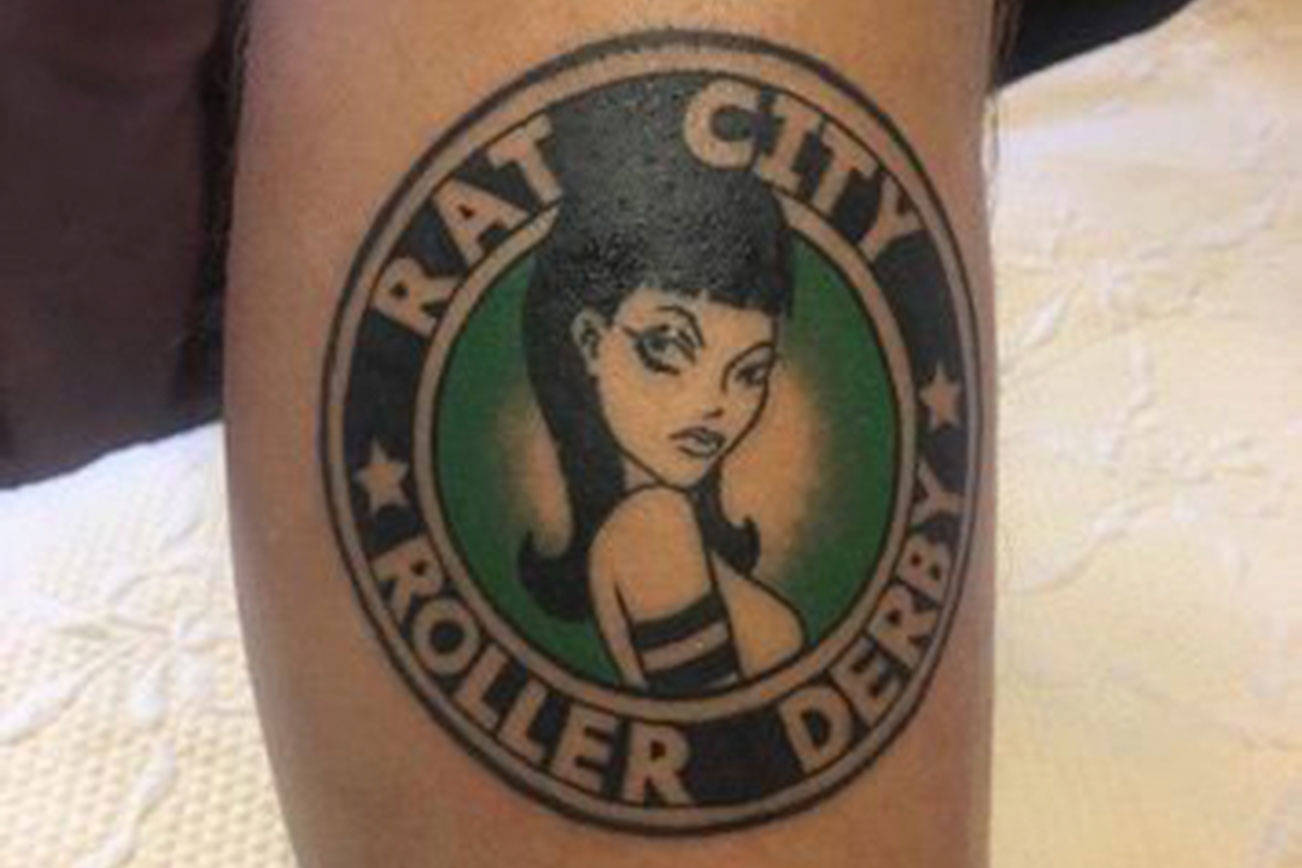The roots of roller derby go back to 1935 when Leo Seltzer, an Oregon theater chain owner-turned-dance- and walking-marathon promoter, saw an article about how most Americans roller skate at least once. He came up with the idea of touring professional marathon roller-skating races with a bunch of two-person coed teams. Sprinting mini-races during those marathons became known as “jams.” Seltzer soon realized the collisions during the jams were the best part—and that skaters should compete with offenses and defenses.
Derby has a convoluted history of leagues coming and going, closely tied to television ratings. Sometimes the rivalries and action were fabricated bombast; sometimes derby was a pure sport without the fakery. A coed derby TV show called RollerGames lasted one season in 1989 with a figure-eight track heavily banked on one side. The coed league faked pro-wrestling-style rivalries, and in the event of a tie, two skaters would race around a pit of alligators. Victory came from finishing five laps first, or from pushing the other skater into the alligator pit. The tie-breaking pit race was used only once.
Today’s style of women’s roller derby was born in 2000 in Austin, Texas, the brainchild of a drifting guitarist named “Devil Dan” Policarpo, who lived in his car while reading Ernest Hemingway and Charles Bukowski. His vision included clowns stabbing each other, bears on fire on unicycles, drummers, and other weirdness. Policarpo also drank lots of whiskey. After a messy organizational meeting, the women dumped the flaky Devil Dan to create today’s Flat Track Derby Association, which now has roughly 300 leagues.
Seattle skaters formed the Rat City Roller Girls in 2004 and joined the FTDA. They based themselves in the south Seattle neighborhood of White Center—nicknamed “Rat City”—where they played at the Southgate Roller Rink. Later the league competed at Key Arena before moving the matches to The Rat’s Nest in Shoreline. The Seattle league changed its name to Rat City Roller Derby in 2017.
Two women who will make their Rat City Roller Derby debut Saturday know the difference between watching roller derby and actually doing it. From the stands, Carmen Abbe and Tanya Powers could see and understand the bigger picture of what was unfolding. But on the track, as Bad Carma and Alter Native, everything is fast and chaotic. Their minds try to keep up with the constantly shifting positions of other skaters. Tactics, rules, and opponents’ tendencies keep swirling in their heads. A reaction time of two seconds is far too slow. “I could do it in my head, but it takes longer to do it with your body,” said Abbe, 22, a University of Washington research coordinator.
The Rat City Roller Girls Debutante Brawl will feature skaters who, like Abbe and Powers, were recently drafted by the league’s four teams. Starting in December, the debutantes will be competing in the Derby Liberation Front, the Socket Wenches (Powers’ team), the Throttle Rockets (Abbe’s), or Grave Danger. The Derby Liberation Front are the undefeated champs from last season. The brawl begins at 5 p.m. Nov. 17 at the The Rat’s Nest in Shoreline.
Powers, 44, is director for baccalaureate programs and workforce for Highline College. For eight years, she watched her daughter Morgayne Lawson skate in Rat City’s junior programs. “It looked like so much fun. I always said I was too old. … I felt like I should work on these self-defeating beliefs,” said the 5′1″ Powers.
Powers is a Native American Yupik from St. Lawrence Island, which is a bit of Alaska in the Bering Sea. Part of her ethnic identity calls for her to try to reclaim what indigenous Americans have lost to white encroachment. In Powers’ mind, battling for space on the derby track is a symbol for reclaiming personal and ethnic space off the track; her ethnic and derby stances feed off each other. “The lessons I learn on the track are lessons that I can apply off the track,” Powers said. But also, it’s fun to hit and get hit on the track: “It’s a contact high,” Powers said, who has had to learn to hit harder.
Throttle Rocket and veteran skater Morgan McShey, whose derby name is Morgan McSlay, also coaches student skaters. She said teammates are rough on each other in practices because those skaters will meet opponents who won’t pull their punches. “It’s hard to hit people sometimes because it is not something you do in normal life,” she said.
A “jam” is a two-minute session on the track, part of a 60-minute match. For a jam, each team puts one jammer and four blockers on the track. Each jammer has to pass all four opposing blockers before she can score a point for each subsequent blocker she later passes. The blockers use several techniques and tactics to keep the jammer from passing them.
Derby has numerous penalties—illegal hitting, drifting off the track to pass a blocker, moving too far ahead of the center mass of blockers to hit a jammer—that send a blocker or jammer to the penalty box or “sin bin” for a minute. That leaves her team without a blocker or a score-making jammer for that minute. Multiple penalties routinely turn five-on-five battles into three-on-two contests. Being fast helps, but a jammer also has to instantly spring back into action after being knocked down by a bigger blocker.
Abbe is being groomed to be a Throttle Rocket jammer, a skater who scores points. “I’m usually exhausted, but it is an amazing feeling when you get through [a wall of blockers],” the 5′5″ Abbe said. “I love it. I wanted to play a physical sport.”








